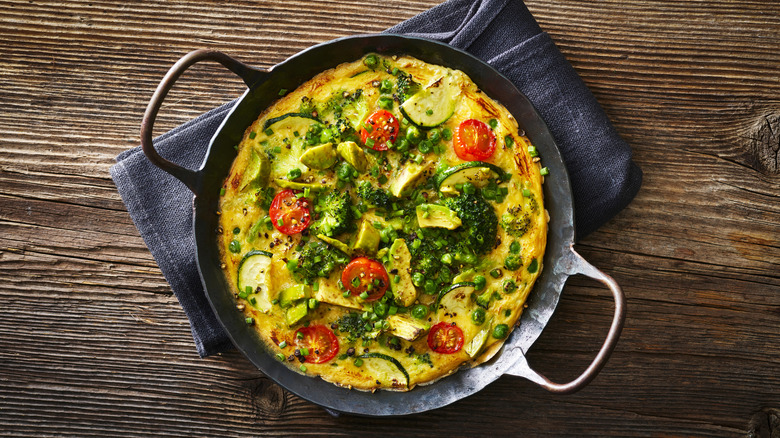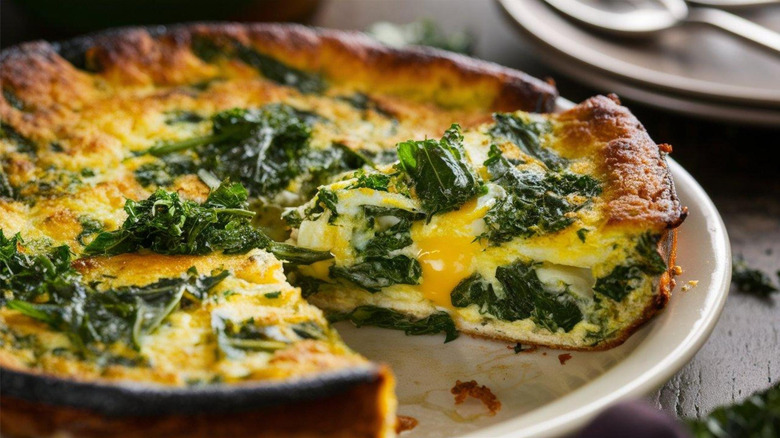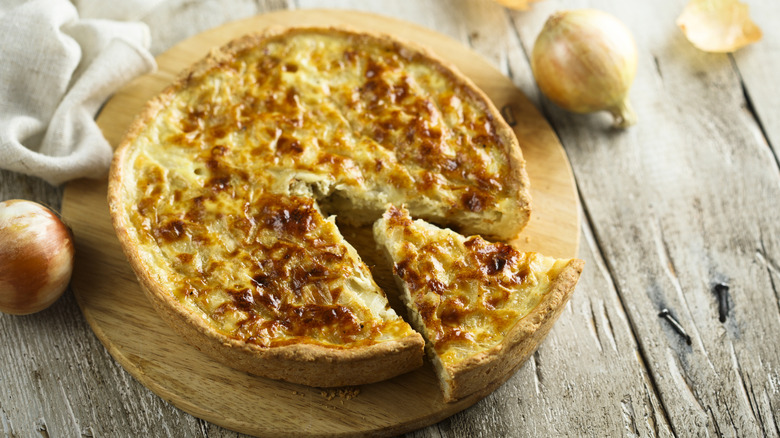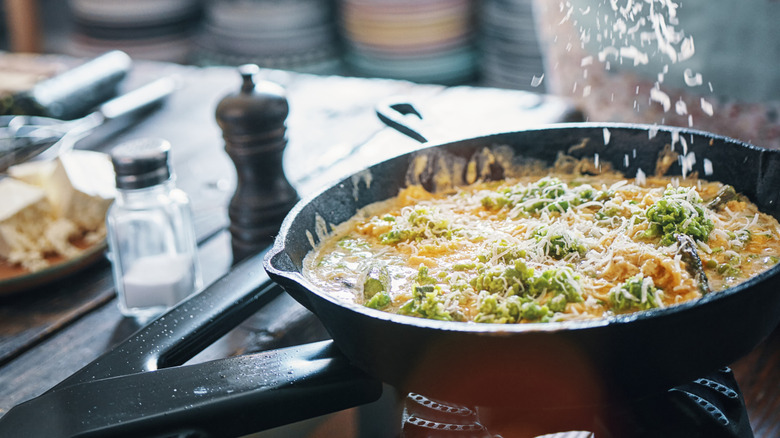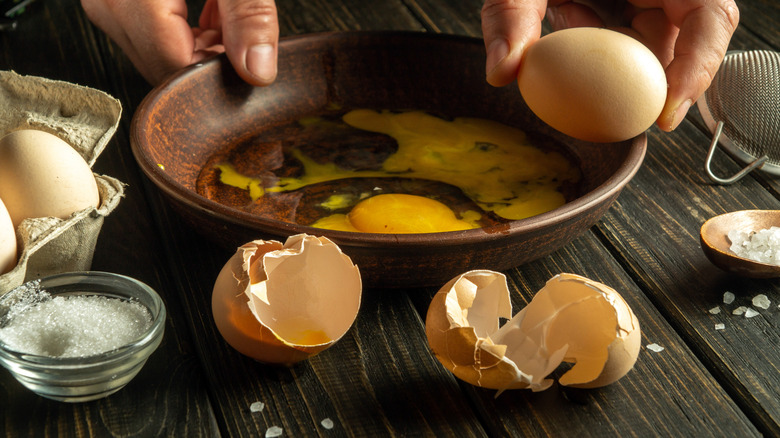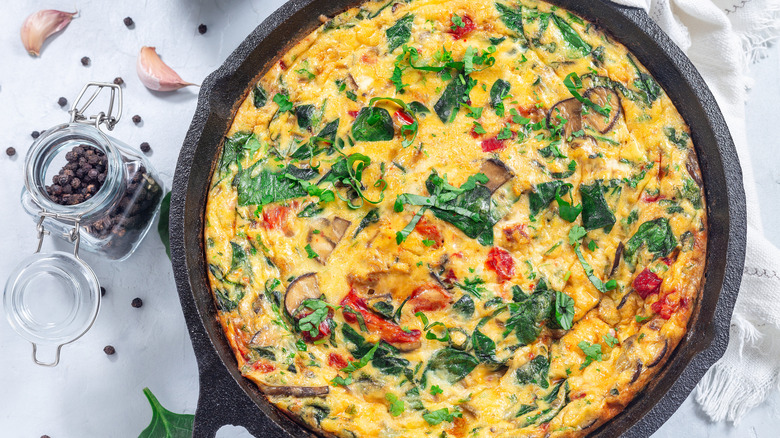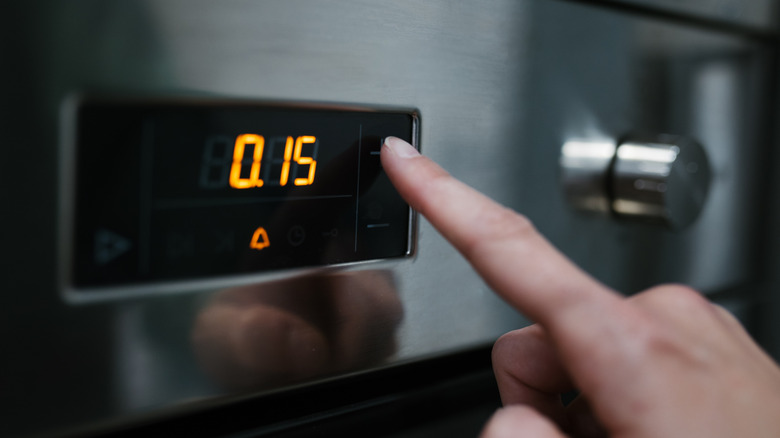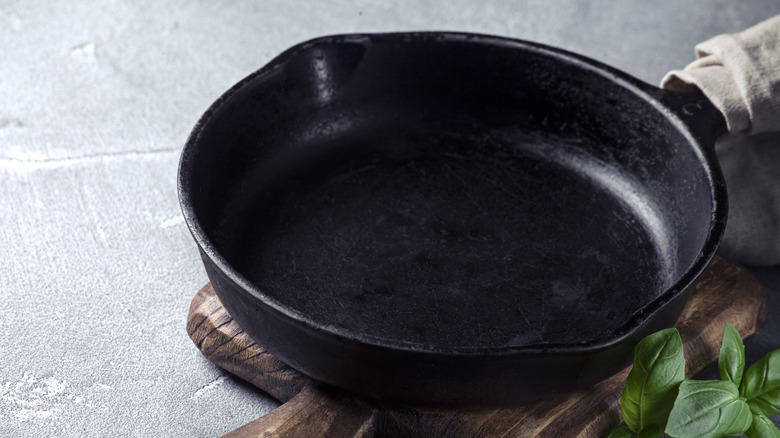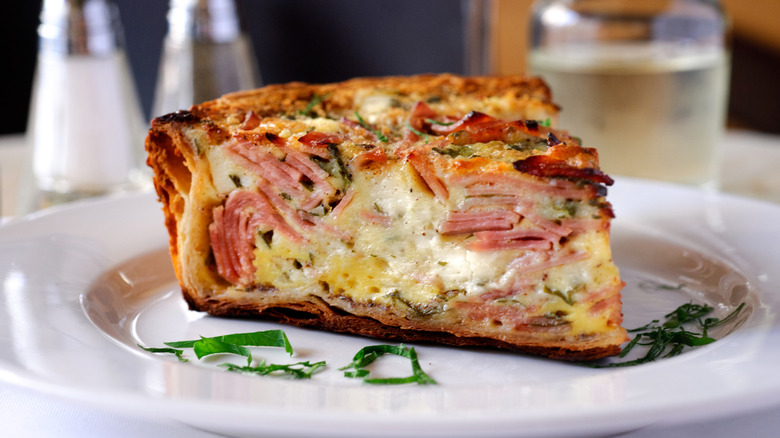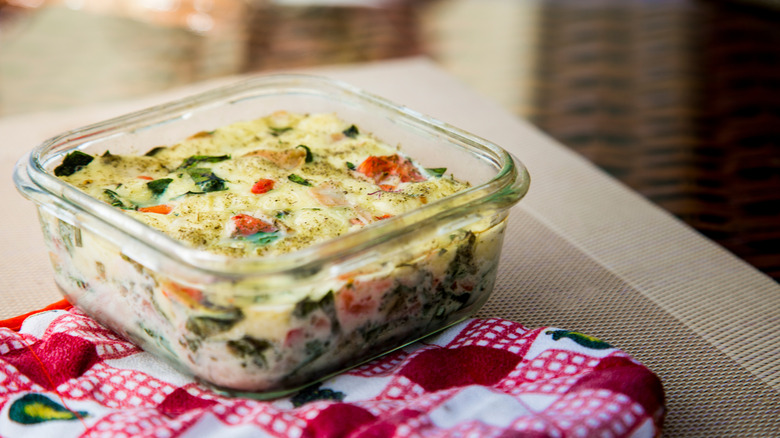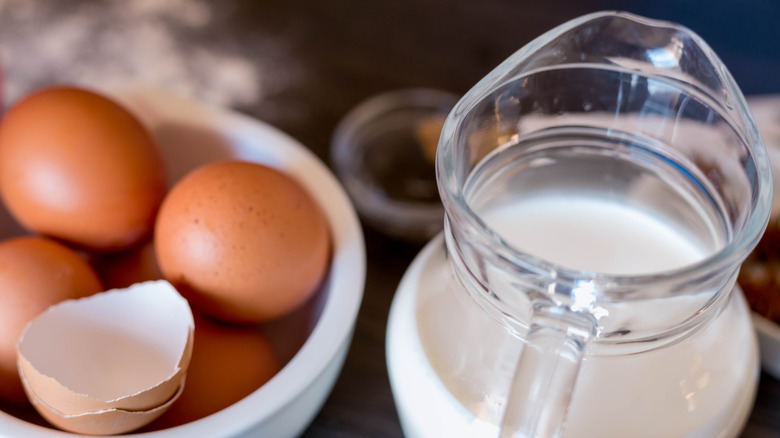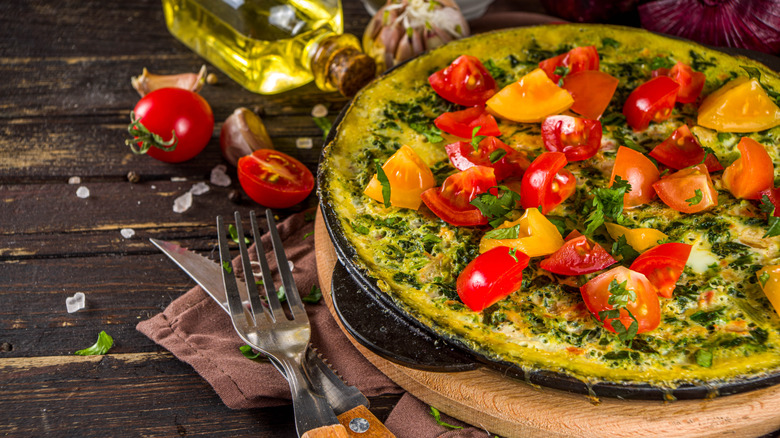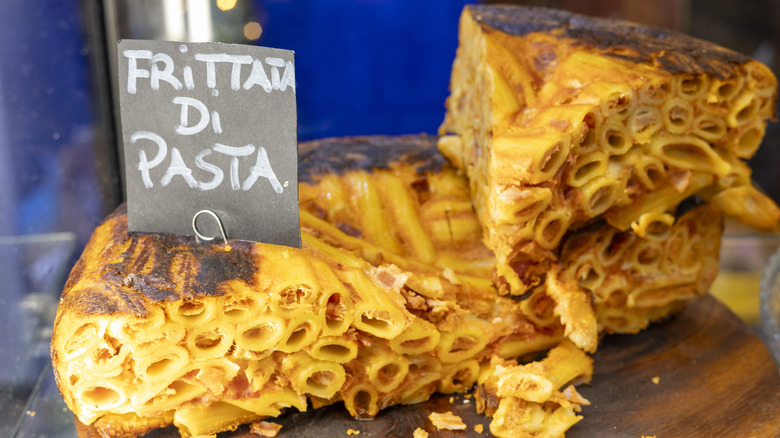Frittata Frenzy: This Is How Italy's Famous Egg Dish Differs From Quiche
Is a frittata just a crustless quiche? Not quite. While they share some similarities, Italy's beloved egg dish differs from its French cousin in several important ways. Frittatas embody the rustic, relaxed spirit of Italian home cooking, often whipped up with whatever ingredients are on hand. Quiches, meanwhile, show the methodical precision that French cuisine is famous for, with careful attention to technique and presentation.
A frittata starts on the stovetop with a quick fry before finishing in the oven, while a quiche takes the slow route, baking gently to achieve its signature texture. They are also completely different in their liquid filling — frittatas use just egg, sometimes with a splash of milk, while quiche has a more custardy filling with much more dairy. Time commitment sets these dishes apart too. A frittata can go from refrigerator to table in under 30 minutes, perfect for weeknight dinners or impromptu brunches. A quiche demands patience, often requiring hours between making the crust, chilling, pre-baking, and finally baking. From their origins, cooking process, and finished product, let's explore what set's these two dishes apart.
What is a Frittata?
The two step process of cooking a frittata, starting off in the skillet and finishing in the oven, gives the frittata the perfect texture, firm and set throughout but not dry or rubbery. The initial stovetop cooking creates that signature crispy bottom and edges.
It is an everyday comfort food in Italy. It celebrates the Italian concept of "cucina povera" or "poor cooking," where simple, available ingredients are transformed into something delicious. This philosophy is at the heart of traditional Italian cuisine, making the most of what you have, reducing waste, and creating satisfying meals without expensive ingredients. Frittatas often incorporate things like leftover pasta, vegetables on the verge of wilting, or that last nub of cheese at the back of the refrigerator.
Nutritionally, frittatas fit perfectly into the Mediterranean diet, offering protein from eggs, vegetables for fiber and nutrients, and often just enough cheese for flavor without overwhelming the dish with fat. Unlike heavier egg dishes loaded with cream and cheese, a traditional Italian frittata maintains a healthy balance that satisfies without weighing you down.
What is a quiche?
A quiche is essentially a savory custard tart, consisting of a buttery shortcrust pastry shell filled with a mixture of eggs and cream, and various fillings. Unlike a frittata, which is primarily an egg dish with some additions, a quiche uses a carefully balanced custard made of eggs and dairy. The higher proportion of fat creates the luxuriously smooth texture that defines a proper quiche.
Originating in the Alsace-Lorraine region of north-eastern France, it's popularity has spread across the globe, but it remains a beloved dish in France, seen in patisseries, cafes and picnics across the country. The preparation method reflects the methodical approach of French cooking, requiring multiple steps, each crucial to the final result. The pastry must be made and chilled, then rolled, shaped, and blind-baked before the filling is even added. But the finished result is decadent and rich, and a classic of French cuisine.
The cooking process
Cooking a frittata is wonderfully straightforward and quick. A skillet is heated over medium and vegetables are sautéed until they're just tender — beaten eggs are then poured in, along with the cheese mixture. The pan gets shaken so the egg spills into all the crevices. It cooks undisturbed until the edges begin to set but the center remains wet. Then it's transferred to a preheated oven (usually around 350 F) for about 10 minutes. This final step gives frittatas their signature texture, slightly crisp on the outside while remaining tender inside. The top should be lightly golden but not browned.
Quiche preparation is more involved,and here's why: Once you've prepared the shortcrust pastry, it needs time to properly chill in the refrigerator, at least 30 minutes. This relaxes the gluten and firms up the butter, which results in a flaky pastry. Next comes blind baking, where you line the chilled crust with parchment paper, fill it with pie weights or dried beans, and partially bake it for 40 minutes. This prevents the dreaded soggy bottom and ensures a crisp base that can stand up to the wet filling.
While the crust pre-bakes, vegetables and meat fillings are cooked and the custard mixture is prepared. Everything gets poured into the partially baked crust, and then baked in a moderate oven (around 325-350 F) until the filling is just set but still slightly jiggly in the center, typically 30 to 45 minutes depending on depth. After baking, the quiche needs to cool for at least 20 minutes before serving to allow the custard to fully set. Rush this step, and you'll end up with a runny interior instead of perfect, sliceable wedges. See, that's a big difference from frittata!
The quiche crust
One of the key distinctions between the two dishes is the lack of crust on a frittata. The traditional quiche crust is made with shortcrust pastry, a mixture of all-purpose flour, salt, cold unsalted butter cut into small cubes, and very cold water. Some bakers add a small amount of sugar, which helps the crust brown more beautifully in the oven. Others add an egg to the dough for stability and a crumbly texture. Making shortcrust pastry is technically demanding and temperature control is crucial, everything must be kept as cold as possible. The longer you work with the dough, the warmer and stickier it becomes as the butter starts to melt.
The effort pays off though, a properly made shortcrust pastry creates a buttery, flaky container that contrasts perfectly with the soft, custardy filling of a quiche. It also helps the quiche hold its shape when sliced, making it easier to serve as a picnic food or appetizer.
The egg ratio
When it comes to the egg mixture, a frittata keeps things simple. For a standard 10 inch skillet frittata, you'll typically use six large eggs, beaten until just combined. Some add a small splash of milk — this does give a more creamy consistency to the frittata, but it's not strictly necessary. The result is a hearty, substantial egg dish with a texture that's firm and satisfying. Quiche, on the other hand, is all about that silky, custardy texture that melts in your mouth due to the higher ratio of dairy to eggs. The standard formula is about half a cup of dairy for every large egg. This creates a proper custard that sets into quivering perfection when baked slowly.
When making quiche, the fat content of your dairy really matters. Low fat milk might seem like a virtuous choice, but it's the fat that gives quiche its creaminess and helps the custard set properly. Whole milk is the minimum, but many recipes call for a combination of milk and heavy cream. Some classic French recipes even go all in with heavy cream alone, creating an indulgently rich custard that's impossible to resist.
Fillings
When it comes to fillings, this is where a frittata and quiche fall into similar territory — you could essentially use the same ingredients for both. Go for whatever needs using up and what you know works well together, Mediterranean flavors are excellent with the Italian frittata. Things like tomato, basil, feta, spring greens, peas, asparagus, or wild mushrooms would pair well with some Italian cheeses such as gorgonzola or pecorino and meats like prosciutto or pancetta. Try our rosemary and olive frittata recipe here or this broccoli, smoked mozzarella and roasted red pepper one if you need some inspiration.
For quiche fillings, you can't go wrong with the classic quiche Lorraine, but also consider what ingredients are already known to work well together, like salmon and watercress or broccoli and cheese. Need some inspiration? Try our French take with a mussels marinière quiche or something a bit outside the box with this full English breakfast version.
One crucial tip applies to both, beware of high water content ingredients. Vegetables like mushrooms, zucchini, and spinach can sabotage your dish by releasing excess moisture during cooking. For quiches especially, this can prevent the custard from setting properly. Always cook these ingredients well first to release all their moisture before adding them to your egg mixture. And when it comes to spinach, make sure to squeeze out the excess water after cooking.
Timing is everything
The beauty of a frittata is that it is so quick. The whole process takes about 20 to 30 minutes — although you should still have a little patience when cooking the eggs. They need to cook nice and slowly so that they remain very moist. Once cooked, ideally it should be served immediately otherwise it goes on cooking and loses its soft creaminess. But it's perfectly acceptable to eat once cooled.
A quiche, on the other hand, is going to take you a few hours, between making the crust, chilling the crust, pre-baking, and all the other steps involved. So really the complete opposite of a quick frittata. However, one thing that will cut down on the time is buying pre-made pastry or even making multiple batches of the pastry and freezing it for later use.
Cookware
For a frittata, a good 10 inch skillet will do the trick perfectly. The key requirement is that it needs to be completely oven safe with no wood or plastic handles that might melt or burn when you transfer from the stovetop to the oven. The absolute best option? A well-seasoned cast iron skillet. It's naturally non stick (when properly maintained), distributes heat evenly, and creates that perfect golden brown crust around the edges of your frittata.
For quiches, most home cooks reach for a standard pie dish, but there are better options. A springform pan, the same kind you'd use for cheesecake, allows you to achieve deeper, more impressive quiches. Standard pie dishes are often too shallow, resulting in a thin layer of filling that can overcook easily. A deeper pan allows the custard to maintain that perfect silky texture in the center. The removable sides of a springform also make presentation much easier, simply unclip the ring and slide it away to reveal your beautiful golden crust. For the best results, look for a 9 inch springform that's at least 2.5 inches deep.
Texture is different
For the frittata, the interior should be firm yet fluffy, similar to a perfectly done omelet. When served hot from the oven, it maintains a tender, almost creamy quality while the edges develop that lovely crispy fried egg texture. As frittatas cool to room temperature, they firm up, making them perfect for cutting into neat squares for picnics or packed lunches. When reheated, frittatas won't return exactly to their original state, but a quick warm-up in the oven — rather than the microwave — helps maintain some of that textural contrast without turning rubbery.
The quiche, meanwhile, is all about that rich, custardy smoothness. The high proportion of dairy creates a silky, almost luxurious mouthfeel that melts on your tongue. This velvety interior is perfectly balanced with the buttery, flaky pie crust. When a quiche comes out of the oven, it should have a slight wobble in the center. If it's completely firm, it's likely overcooked and may have a grainy texture rather than that silky smoothness you're after. The quiche will continue to set as it cools, so that wobble is crucial.
Storing and reheating is similar
Frittatas and quiche have similar storage guidelines. Both will last about three or four days in a refrigerator. The longer a frittata sits in the fridge, the more moisture it will lose, gradually becoming drier. If you don't plan to eat it within a day or two, freezing is your best option. Properly stored, frittata will last in the freezer for three to four months and quiche will last up to around three months. For both dishes, it's crucial they are completely cooled before freezing. If they're still warm, they'll release steam into the container, which will form ice crystals and affect the texture once defrosted.
To reheat a refrigerated frittata, add it to a skillet, cover with foil, and bake in the oven at 350 F for five to seven minutes or until hot. For frozen frittata, thaw in the refrigerator before reheating. When reheating quiche, let it defrost in the fridge overnight and then heat in a 350 F oven until warmed through, about 20 to 25 minutes. Covering the crust with foil will prevent it from over-browning during reheating.
The origins
The word "frittata" comes from the Italian verb "friggere," which simply means "to fry." But pinpointing exactly when the first Italian cook decided to mix eggs with leftover vegetables and cheese is a bit trickier. There's no specific date or region we can definitively point to and say, "That's where the frittata was born!"
The origins of quiche are better documented than the frittata. This French dish comes from the Alsace-Lorraine region, which sits right on the border between France and Germany. The name hints to its mixed heritage, the word "quiche" comes from the German word "kuchen," meaning "cake," which French speakers adapted over time. The original version, Quiche Lorraine with its egg custard and smoky bacon, became popular throughout this region long before today's country borders were firmly established. Alsace-Lorraine switched between French and German control multiple times over the centuries and the dish represents the area's complicated history.
Occasion
The frittata is not something commonly found in restaurants in Italy. It is the epitome of home cooking in a way that quiche simply isn't. Frittatas represent practical, everyday Italian cuisine at its finest. Italian home cooks might whip up a frittata on a weeknight when time is short, or when unexpected guests arrive. There's no careful measuring or precise timing required, just intuitive cooking that adapts to whatever ingredients are on hand.
The classic Italian way to enjoy frittata is served on a slice of Italian bread like an open faced sandwich. Often accompanied by cold cuts like prosciutto or salami during lunch, shared among family, passed around the table along with conversation and laughter. Quiche, by contrast, requires planning and precision. The delicate pastry crust demands attention, specific ingredients, and time, which is why it's more commonly found in restaurants, cafés, and bakeries.
Regional twists
Frittata di pasta is a version that is found all over Naples. It is filled with leftover pasta and cheese and becomes dense and thick, cut into thick slices. From the region of Basilicata, in the south, right in the arch of Italy's boot, you can find rafanata, a frittata made with pecorino cheese and spicy fresh horseradish root, with mashed potato to give it a light fluffy texture. It is made during the winter months as that's when the fresh horseradish is in season.
In terms of quiche, Quiche Lorraine is the most beloved version. This classic consists of cream, eggs, and bacon. The thick cut bacon (lardons) give a smoky flavor and the use of heavy cream makes it rich and indulgent. There is some debate around whether or not to use cheese, but traditionally it isn't used. If cheese is included in modern versions, Gruyere is the preferred choice for its nutty flavor.

